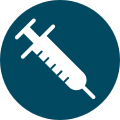Bats are the main source of rabies in Washington. Avoid contact with bats and teach children to never touch bats.
Rabies is a rare viral disease that affects mammals, including humans. Only a small percentage of bats are infected with rabies. However, rabid bats are found in Washington every year.
Spring and summer are bat season.
Encounters between bats and people increase in the spring and summer as bats become more active. Keeping bats out of your home is the easiest way to reduce your risk of being exposed to rabies. Simple steps include adding screens to windows and doors and covering exterior openings that could allow bats to get inside.

Disease Information
Communicable diseases are diseases that spread between people or animals. Click on the buttons below to learn about specific diseases. For more disease information, visit the CDC's health topics index.

Our vision:
A safe and healthy Kitsap County for all.
Communicable Disease Data Dasbhoards
This report displays respiratory virus trends for Kitsap County based on data from healthcare facilities and laboratory testing. The Respiratory Illness Report is published weekly during respiratory illness season (typically fall and winter months) and published monthly when respiratory illness activity is low. You can subscribe to receive this report by email or text.
What to know about rabies
Rabies is a disease caused by a virus that infects the nervous system
Rabies almost always causes death if it isn't treated quickly
Rabies is 100% preventable with prompt medical care
Learn more about rabies
How rabies spreads
Rabies virus is spread through the saliva of an infected animal. In Washington, rabies is most often spread by bats.
People and animals can get rabies if they are bitten or scratched by an infected animal.
It is not possible to know if an animal has rabies just by looking at it. Testing is needed to confirm rabies.
Bat bites and scratches are not always noticeable because bats have tiny teeth and claws.
Preventing rabies
Make sure your pets are up-to-date on rabies vaccine.
Avoid touching bats. Never touch a bat with bare hands, even if it is dead.
Teach children never to touch bats and to tell an adult if they find a bat.
Keep bats out of your house. Learn more about "bat-proofing."
Enjoy wildlife from a safe distance. Don't feed or touch wild animals.
What to do if someone has contact with a bat
Follow these steps if someone has had bare-skin contact with a bat, or might have had contact with a bat:
Wash the bite, scratch, or contact area immediately with soap and water for at least 10 minutes
Attempt to safely capture the bat if possible. If you can capture the bat, it can be tested for rabies.
Contact your healthcare provider and/or Kitsap Public Health District for guidance as soon as possible. Call us at 360-728-2235.
If you think your pet was exposed to a bat, contact a veterinarian
More rabies resources
Information about bats
Information about rabies
Information about rabies and pets

Using a mobile device? These data dashboards cannot be viewed on a phone or tablet. Please visit this webpage from a computer.








.png)
